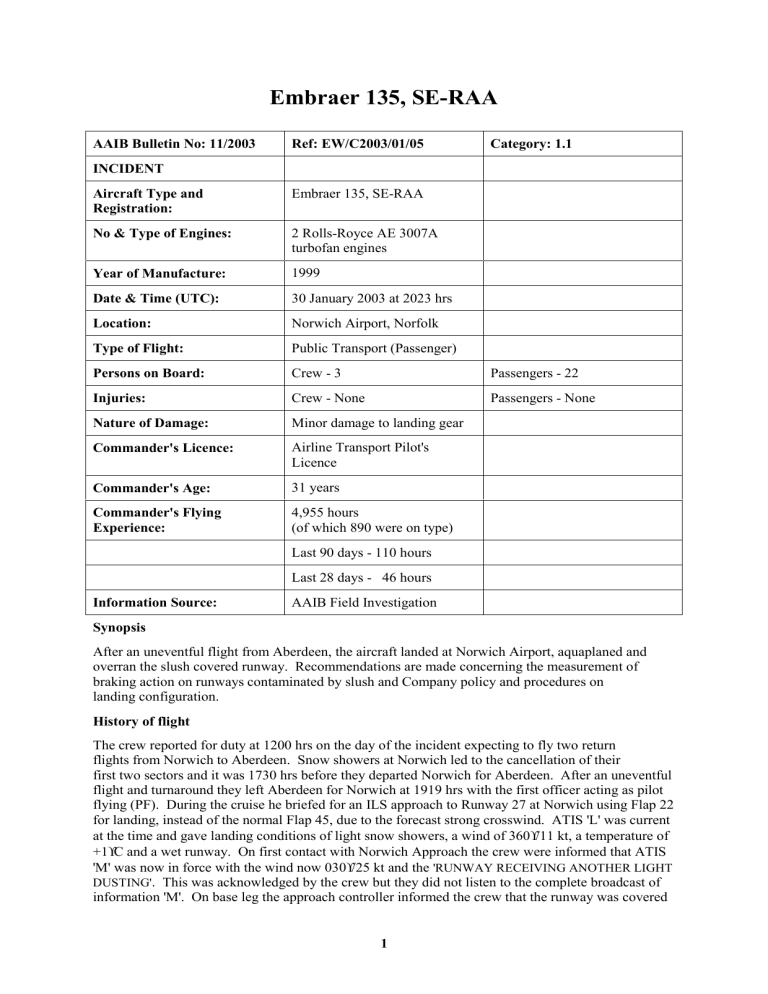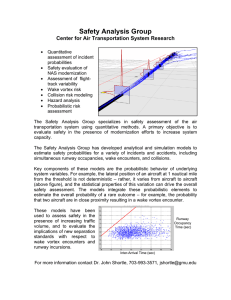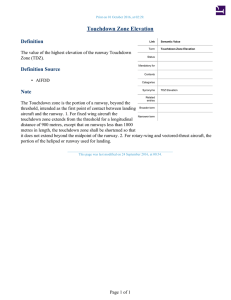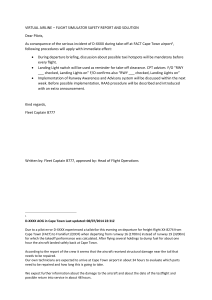
Embraer 135, SE-RAA AAIB Bulletin No: 11/2003 Ref: EW/C2003/01/05 Category: 1.1 INCIDENT Aircraft Type and Registration: Embraer 135, SE-RAA No & Type of Engines: 2 Rolls-Royce AE 3007A turbofan engines Year of Manufacture: 1999 Date & Time (UTC): 30 January 2003 at 2023 hrs Location: Norwich Airport, Norfolk Type of Flight: Public Transport (Passenger) Persons on Board: Crew - 3 Passengers - 22 Injuries: Crew - None Passengers - None Nature of Damage: Minor damage to landing gear Commander's Licence: Airline Transport Pilot's Licence Commander's Age: 31 years Commander's Flying Experience: 4,955 hours (of which 890 were on type) Last 90 days - 110 hours Last 28 days - 46 hours Information Source: AAIB Field Investigation Synopsis After an uneventful flight from Aberdeen, the aircraft landed at Norwich Airport, aquaplaned and overran the slush covered runway. Recommendations are made concerning the measurement of braking action on runways contaminated by slush and Company policy and procedures on landing configuration. History of flight The crew reported for duty at 1200 hrs on the day of the incident expecting to fly two return flights from Norwich to Aberdeen. Snow showers at Norwich led to the cancellation of their first two sectors and it was 1730 hrs before they departed Norwich for Aberdeen. After an uneventful flight and turnaround they left Aberdeen for Norwich at 1919 hrs with the first officer acting as pilot flying (PF). During the cruise he briefed for an ILS approach to Runway 27 at Norwich using Flap 22 for landing, instead of the normal Flap 45, due to the forecast strong crosswind. ATIS 'L' was current at the time and gave landing conditions of light snow showers, a wind of 360°/11 kt, a temperature of +1°C and a wet runway. On first contact with Norwich Approach the crew were informed that ATIS 'M' was now in force with the wind now 030°/25 kt and the 'RUNWAY RECEIVING ANOTHER LIGHT DUSTING'. This was acknowledged by the crew but they did not listen to the complete broadcast of information 'M'. On base leg the approach controller informed the crew that the runway was covered 1 Embraer 135, SE-RAA in 'SLUSH MIXED WITH HAIL TO A DEPTH OF 2-3MM.... YOU CAN STILL SEE THE WHITE LINES THROUGH THE SLUSH.' Although the crew acknowledged this, they had no recollection after the incident of receiving this information. During the descent the crew also received an Engine Indication and Crew Alerting System (EICAS) Stall Protection System (SPS) warning which had illuminated due to ice accretion. In accordance with company procedures they added 6 kt to their approach speed (VAPP) giving them 130 kt as their VAPP and 120 kt as their VREF. During the final stages of the ILS approach, the Norwich tower controller gave three further readouts as the wind veered and increased. On touchdown the wind was 020°/23 kt giving a tailwind component of 10 kt and a crosswind component of 21 kt. The first officer flared the aircraft as normal and then felt the right wing drop. He corrected for this but the aircraft floated down the runway, touching down at 120 kt, between 500 and 600 metres from the threshold. Fire crews, who were on weather standby and pre-positioned near the taxiway/runway intersection at B1, 500 metres from the threshold of Runway 27, reported that the aircraft touched down beyond the intersection. In accordance with the company Standard Operating Procedures (SOP's), the Commander called 'MY BRAKES', pressed the brake pedals but felt no retardation. He tried several times with no effect and even the application of the parking brake, which applies full system pressure, made no noticeable difference to the aircraft's rate of retardation. The first officer transmitted that they were 'GOING OFF THE END OF THE RUNWAY' and they left the paved surface at a ground speed of 74 kt. The overrun area was a field covered in snow. This produced significant retardation and they came to rest 130 metres after leaving the paved surface. The fire crews were in attendance at the aircraft just after it came to a stop. There were no immediate signs of damage or fire and, after the crew had shut down the engines, the passengers disembarked in the normal manner. Accident site The overrun area, at the end of the tarmac surface of Runway 27, was very wet grass covered soil over laid by a thin layer of soft snow. The aircraft departed the end of the tarmac surface to the left of the runway centreline on a heading of approximately 280°. As the aircraft entered the overrun area the wheels sank into the soft ground greatly assisting its deceleration. The aircraft travelled 130 metres before coming to rest with its main wheels buried in the soft ground to just above the axles. Aircraft examination Examination of the aircraft revealed minor damage to the lower edges of both fixed main landing gear doors and rubber reversion damage on all four main landing gear tyres indicative of aquaplaning. There were also areas of angled scuff marks on the tyre treads. The angle of these scuff marks was approximately 15° to the right of the centreline of the tread indicating that, at sometime during the landing roll on the runway, the aircraft had slid to the right. The main wheels were changed and the mud removed from the landing gear areas. Slow and fast taxi runs were carried out followed by a flight test. The braking system was found to function satisfactorily and the aircraft was released to service. Flight Recorders The solid state FDR and CVR retained complete recordings of aircraft data and audio from the event. The FDR recorded two relevant brake parameters, the metered pressures at the left outboard and right inboard wheels. Brake pressure at the other two wheels was not recorded neither were any parameters related to anti-skid operation or locked wheel protection. Selected parameters, relating to the events during the landing, are shown in Figure 1. During the first 7 seconds of the rollout, retardation increased under manual braking to give longitudinal accelerations of -0.3g. During the following 9.5 seconds the retardation reduced although a similar degree of braking was applied (by comparison of the recorded brake pressure at two of the wheels). The crew quickly recognised and commented on the fact that they had "no brakes". During this second phase of the rollout longitudinal acceleration values varied between 2 Embraer 135, SE-RAA -0.25g and -0.14g and airspeed only decreased from 100 kt to 82 kt. Corrective rudder pedal had been used to maintain the runway centreline up to this point. Six seconds before the aircraft departed the end of the runway surface, the metered brake pressures on the two wheels recorded (left outboard and right inboard) reduced to a low level and ATC were advised that the aircraft was "GOING OFF THE END OF THE RUNWAY". One and a half seconds later the aircraft began to yaw progressively to the right but departed to the left of the centreline. This indicated that the aircraft was sliding to the left. Left rudder pedal was applied to counter the change in heading but the right yaw continued. From the recorded data, the aircraft departed the paved surface with an airspeed of just under 66 kt approximately 7 metres to the left of the centreline but heading to the right of the centreline by 17°. A normal acceleration of +1.5g was recorded at that point. The aircraft then began to decelerate rapidly. The aircraft braking system provided anti-skid and locked wheel protection functions. In the absence of recorded data for all wheel speeds and metered pressures at the left inboard and right outboard wheels, it was not possible to categorically state that some of the wheels were skidding or even locked. However, given the reported runway surface conditions, it is likely that asymmetric retardation from wheel braking was a contributory factor. The aircraft manufacturer, in their assessment of the recorded data, reached a similar conclusion. The right yaw continued to a maximum magnetic heading of 293° before starting to reduce. Localizer deviation also started to reduce as the aircraft began to track right and regain the extended centreline. Below 44 kt airspeed the ground spoilers retracted and both recorded brake pressures smoothly increased to over 2,200 psig before reducing to nearly zero again. Three seconds later the aircraft had come to a stop, just to the right of the extended centreline and on a heading of 278°. Both engines were shut down within one minute and the recordings terminated. During the investigation the AAIB reviewed the concerns about the recording system previously raised in Bulletin 05/2002 regarding anomalies in data sampling of various parameters and accuracy of recorded groundspeed. Four recommendations were made in that report to correct the problems on existing and future aircraft equipped with the recording system in question. The aircraft manufacturer has investigated these concerns and provided solutions in the form of software updates detailed in two Service Bulletins. At the time of compiling this report the Service Bulletins are lodged with the Centro Tecnico Aeroespacial (CTA) in Brazil for approval. The AAIB has written to the CTA to emphasise the importance of introducing corrective action on existing aircraft and urged them to designate the Service Bulletins as mandatory. ATC/ATIS At the time of the incident, the policy of the airport authority was not to update the ATIS during rapidly changing runway states but for the approach controller to inform individual aircraft of the latest runway conditions. This meant, on this occasion, that at the time the crew briefed for their approach they were expecting the runway to be wet in all segments. They were only made aware of the possible contamination when on base leg for the ILS. Performance Having received ATIS 'L', the crew, as stated above, were expecting to land on a wet runway with a crosswind but no headwind component. They briefed accordingly and opted for a Flap 22 landing. Table 9 in their Route Performance Manual (RPM) details that with these conditions, they required a landing distance available (LDA) of 1,730 metres. In reality they landed with a 10 kt tailwind component and with a 6 kt increase to VAPP, following the SPS warning. These variations increased the LDA requirement to 2,150 metres. Runway 27 at Norwich Airport has a LDA of 1,841 metres and a stopway of 87 metres. Contamination 3 Embraer 135, SE-RAA JAR-Ops 1.480(2) states that: 'A runway is considered to be contaminated when it has more than 25% of its surface area (whether isolated areas or not) within the required length and width being used covered by ...slush or loose snow with a Water Equivalent Depth (WED) of more than 3 millimetres.' The 2-3 millimetres of slush mixed with hail on the runway, reported by the approach controller, converts to a WED of between 1.70 mm and 2.55 mm which means that, in performance terms, the runway was not contaminated and thus the contamination figures from the RPM did not need to be applied. Braking Action After the last snow shower, the Airfield Fire Service (AFS), at the request of ATC, inspected the runway to report the type and depth of any contaminant. They reported 2-3 millimetres of slush covering the whole of the runway area but were unable to provide a report on the braking action. The equipment used by the airport was unable to produce reliable braking action reports in conditions of wet snow or slush due to technical limitations. CAP 168 (Licensing of Aerodromes) Chapter 3 Appendix 3D states that in relation to slush: 'where contaminant remains, runway condition reports shall not contain readings taken directly from friction measuring machines' Although many airlines' performance tables provide a direct correlation between type of contaminant and braking action, in order to calculate a crosswind limit, this was not the case with this company. Had the crew wished to check their landing crosswind limitation, they would have required a braking action report from ATC. Shortly after the incident the AAIB requested a runway friction reading and this was not available for the same reason. No method exists of providing an accurate measure of runway friction co-efficient in wet snow or slush conditions. All attempts from industry to develop a suitable device have so far been unsuccessful. In some cases these unreliable readings have been applied inappropriately to the snow and ice tables in the UK Aeronautical Information Publication (AIP) and passed to pilots. The CAA have advised therefore, that any braking coefficient values provided by ATC to a pilot would be misleading and hence ATC are directed that they should not be given. Airfields contaminated with slush should close until the slush is cleared and the runway returned to its 'blacktop' state. Flap 22 Pilots within the company are advised to consider landing with Flap 22 in strong crosswind conditions. There is no written procedure to this effect but the generally held view is that it results in a more stable approach and the aircraft is directionally easier to control during the landing flare. The difference between minimum and maximum speeds is also greater when using Flap 22 giving more leeway in gusty conditions for an increase of only 2 kt to VREF. The approach and landing attitude are almost identical in this configuration which should minimise the flare, however, if the aircraft is flared early, it is more susceptible to float than when using Flap 45. Embraer recommend landing with Flap 22 only with specified abnormalities or for Category 2 (low visibility) procedures and crews are led to this configuration by the Quick Reference Handbook (QRH) checklists. They have issued no documentary advice regarding using Flap 22 for landing in other circumstances. Analysis The crew appeared unaware of how critical the LDA at Norwich Airport was for their approach in the prevailing conditions. Their arrival brief was based on ATIS information that was benign compared to the conditions actually encountered. Had the crew consulted any of the tables in the RPM at this point however, they would have realised that minor changes in the landing conditions or a less than accurate approach and touchdown would have resulted in a critical situation. A more thorough brief 4 Embraer 135, SE-RAA may have enabled them to identify exactly what weather changes would require a diversion, eliminating the need to consult RPM tables during the high workload period of the approach. On first contact with Norwich Approach they were advised of a significant change in wind speed and direction and shortly afterwards received the SPS warning requiring an increased approach speed. These factors meant that, according to the RPM tables, a runway excursion was inevitable. Later they were informed of slush on the runway and, whilst on short finals, there were several ATC transmissions informing them of the wind speed, none of which appear to have been fully comprehended by the crew. The crew reported that they were familiar with Norwich Airport and held the braking ability of the aircraft in high regard. This may explain why they did not feel it necessary to use the RPM tables. Although the crew did not listen to ATIS 'M', there were at least four transmissions from Norwich ATC advising of a significant increase in crosswind and tailwind and several clues to the deteriorating runway state. If the ATIS had more accurately reflected the runway state it is possible that they would have been more alert to the deteriorating conditions. Furthermore a braking action assessment relayed by ATC, had they been able to provide one, may also have prompted the crew to reconsider their approach. The decision to land with Flap 22, whilst condoned by their company, is unusual within the wider Embraer community. Although an accurate touchdown point can be achieved with Flap 22, a poorly executed flare, which in this incident may have been caused by the gusty conditions, can lead to a prolonged float and subsequent delayed touchdown. This could account for some of the 500 metres to 600 metres (27% to 32%) of runway overflown before touchdown. The company had no written procedure regarding the use of Flap 22 for landing. This may have reduced the crew's awareness as to its use and implications. Embraer do not advise Flap 22 for landing other than in Category 2 (low visibility) or abnormal situations. It would appear that aquaplaning began to occur after touchdown. Embraer advise that in this condition the aircraft should maintain the runway centreline and the crew should keep braking until the aircraft is decelerated. Use of the parking brake in these circumstances is not recommended as this removes anti-skid protection and causes the spoilers to close. No method exists of providing an accurate measure of runway friction co-efficient in wet snow or slush conditions and it would appear that all attempts by industry to develop a suitable device have so far been unsuccessful. Notwithstanding this situation the provision of a reliable accurate method of braking coefficient measurement under these conditions could allow airfields to remain open or reopen more quickly. Accurate braking action reports from ATC would also highlight any runway contamination and provide the pilot with definitive information upon which he could make considered landing and take-off performance decisions. Given the average temperatures in the UK in winter and the likelihood of slush contamination rather than snow being the norm, it appears unsatisfactory not to be able to measure the runway braking action in slush conditions. There have been several Confidential Human Factors Incident Reporting Programme (CHIRP) reports from Air Traffic Control Officer's who are concerned that they have been unable to pass braking action reports to flight crews. The CAA's response was that it had: 'facilitated several discussions with a cross-section of stakeholders and promulgated widely the advice derived from research that movements on a runway should cease while it is contaminated with wet snow and slush.' They also commented that there appeared to be a complete disconnect between information provided by aircraft manufacturers, the actual runway conditions experienced and runway test vehicle manufacturer's results. Finally, the rapid response to the incident from the AFS justifies the decision to place them on a weather standby alert. This response enabled the passengers to disembark in a timely and orderly manner without further incident. 5 Embraer 135, SE-RAA Follow up action As a result of the incident the airport now changes the ATIS information whenever the runway state changes and continues to back this up with information from the approach controller. The company have subsequently issued information to pilots regarding speed control on approach and amended the procedures for determining approach and landing speeds. Landing performance charts, have also been changed to make them more user friendly and they now include information on slush contamination. Additionally, special landing charts for short runways and more restrictions on the use of Flap 22 on short, wet runways have been added to the route performance manual. Furthermore the company intend to issue a new company Standard Operating Procedures (SOP) manual that will now also include information on Flap 22 landings and a ruling that company aircraft will not land on runways where a current braking action report is not available. Crews will also undergo recurrent winter operations performance training. Safety recommendations The following safety recommendations are made: Safety Recommendation 2003-96 It is recommended that the CAA encourage research that could lead to the production of equipment that can accurately measure the braking action of runways under all conditions of surface contamination. Safety Recommendation 2003-97 It is recommended that City Airline, review its Embraer 135 landing configuration policy and, in consultation with Embraer Brasileira de Aeronautica SA, produce a comprehensive written procedure that includes advice and highlights the ramifications associated with the execution of a 'Flap 22' landing. 6




